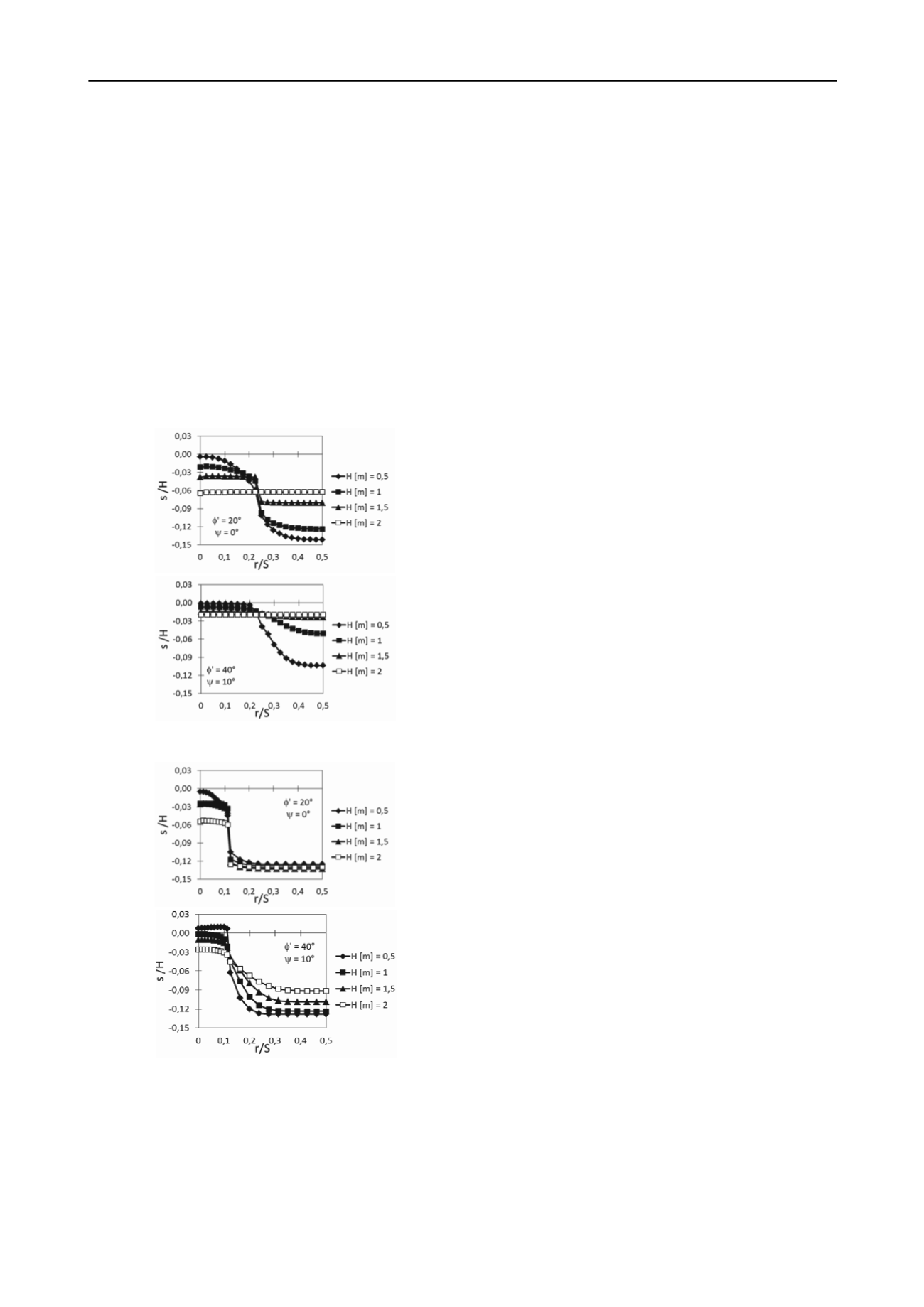
2476
Proceedings of the 18
th
International Conference on Soil Mechanics and Geotechnical Engineering, Paris 2013
assumed; the mechanical behavior of both the materials
constituting the embankment and the soft soil has been modeled
by assuming an elastic perfectly plastic relationship with a non-
associated Mohr-Coulomb failure condition. For the
embankment, two different types of material have been
considered: a loose sand (
=20°, with no dilatancy) and a
compacted sand (
=40°, with dilatancy
=10°). In both cases,
for the sake of simplicity the unit weight
is assumed to be
equal to 20 kN/m
3
, the Young modulus equal to 3 MPa and the
Poisson coefficient equal to 0.25. No friction has been
considered at soil-column interface. For the soft soil, for the
sake of simplicity a dry condition has been assumed (i.e. no
hydro-mechanical coupling has been modeled). The values of
the mechanical parameters are listed in Table 1. Consistently
with the parametrical analyses previously discussed, the length
L of the column is 10 m and its diameter D is 80 cm. Two ratios
S/D have been considered, and the settlement distribution s(r)
has been normalized at each stage for the current value of H.
a)
b)
Figure 6. Normalized superficial settlements for S/D=2: (a) loose and
(b) dense material.
a)
b)
Figure 7. Normalized superficial settlements for S/D=4: (a) loose and
(b) dense material.
Figures 6 and 7 describe the evolution of s(r) at the top of the
embankment during the construction stages. It appears clearly
that the settlement profile ranges from a well localized punching
failure mechanism to a smooth distribution of settlements for
increasing H (witnessing the progressive mobilization of the
arch effect). The influence of relative spacing S/D and of the
mechanical properties of the embankment (in terms of both
’
and
) is opposite: an increase in S/D tends to localize the
failure, whilst an increase in
’ and
tends to smoothen the
settlement profile.
5 CONCLUSIONS
The paper critically discussed some results obtained according
to the usual Design Standards, and proved that in some cases
these approaches lead to unrealistic results. The codes,
moreover, disregard the estimation of relative settlements at the
top of the embankment, which is actually one of the most
important parameters describing the efficiency of the
foundation. A consistent, displacement based conceptual
framework for describing the behavior of the system has been
formulated, and some preliminary numerical analyses have been
shown. These latter, in particular, showed on the contrary that
the top settlement profile is remarkably affected by both the
geometry and the mechanical properties of the embankment.
6 ACKNOWLEDGEMENTS
The Authors want to acknowledge TENCATE and ITASCA
Italy for financially supporting the research.
7 REFERENCES
British Standard BS 8006. 1995. Code of practice for
strengthened/reinforced soils and other fills.
British Standards
Institution
, London, UK pp.176.
di Prisco C. and Galli A. 2011. Mechanical behaviour of geo-encased
sand columns: small scale experimental tests and numerical
modeling.
Geomechanics and Geoengineering: An International
Journal
6(4), 251–263
EBGEO. 2003. Empfehlung 6.9 (2003). Bewehrte Erdkörper auf
punktoder linienförmigen Traggliedern, Kapitel 6.9 für die
Empfehlungen für Bewehrungen aus Geokunststoffen, EBGEO,
DGGT (German Geotechnical Society).
Galli A. and di Prisco C. 2011. Un modello concettuale per la
progettazione di colonne granulari georinforzate a fondazione di
rilevati artificiali (in Italian).
XXIV Convegno Nazionale di
Geotecnica
, 231 – 246.
Ghionna V.N. and Jamiolkowski M. 1981. Colonne di ghiaia (in
Italian).
X Ciclo di conferenze dedicate ai problemi di meccanica
dei terreni e ingegneria delle fondazioni: Metodi di miglioramento
dei terreni
. Politecnico di Torino, Atti dell’Istituto di Scienza delle
Costruzioni, n.507, pp.1-63.
Jones C.J.F.P., Lawson C.R., Ayres D.J. 1990. Geotextile reinforced
piled embankments.
Geotextiles Geomembranes and Related
Products
, Den Hoedt (ed.) © 1990 Balkema, Rotterdam, ISBN 90
6191 119 2, pp 155-160.
Kempfert H.G. 2003. Ground improvement methods with special
emphasis on column-type techniques.
Int. Workshop on
Geotechnics of Soft Soils-Theory and Practice- SCMEP
.
Marston A. and Anderson A.O. 1913. The theory of load on pipes
ditches and tests of cement and clay drain tile and sewer pipes.
Bulletin 31. Iowa Engineering Experiment Station
, Iowa State
College, Ames, Iowa.
Moraci N. and Gioffrè D. 2010. La progettazione di rilevati su terreni
compressibili rinforzati con geosintetici (in Italian).
Rivista Italiana
di Geotecnica
, vol. 3/10, 67-100.
Murugesan, S. and Rajagopal, K. 2006. Geosynthetic encased stone
columns: Numerical Evaluation.
Geotextiles and Geomembranes
,
Vol. 24, 349-358.
Raithel M., Kirchner A., Schade C. and Leusink E. 2005. Foundation of
Constructions on Very Soft Soils with Geotextile Encased Columns
- State of the Art.
Proceedings ASCE Geo-Frontiers 2005
.
Zaeske D. 2001. Zur Wirkungsweise von unbewehrten und bewehrten
mineralischen
Tragschichten
über
pfahlartigen
Gründungselementen, Schriftenreihe Geotechnik. Universität
Kassel, Heft 10.


